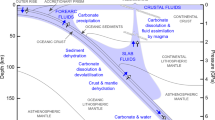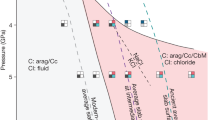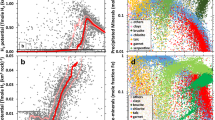Abstract
The net flux of carbon between the Earth’s interior and exterior, which is critical for redox evolution and planetary habitability, relies heavily on the extent of carbon subduction. While the fate of carbonates during subduction has been studied, little is known about how organic carbon is transferred from the Earth’s surface to the interior, although organic carbon sequestration is related to sources of oxygen in the surface environment. Here we use high pressure–temperature experiments to determine the capacity of rhyolitic melts to carry carbon under graphite-saturated conditions in a subducting slab, and thus to constrain the subduction efficiency of organic carbon, the remnants of life, through time. We use our experimental data and a thermodynamic model of CO2 dissolution in slab melts to quantify organic carbon mobility as a function of slab parameters. We show that the subduction of graphitized organic carbon, and the graphite and diamond formed by reduction of carbonates with depth, remained efficient even in ancient, hotter subduction zones where oxidized carbon subduction probably remained limited. We suggest that immobilization of organic carbon in subduction zones and deep sequestration in the mantle facilitated the rise (∼103–5 fold) and maintenance of atmospheric oxygen since the Palaeoproterozoic and is causally linked to the Great Oxidation Event. Our modelling shows that episodic recycling of organic carbon before the Great Oxidation Event may also explain occasional whiffs of atmospheric oxygen observed in the Archaean.
This is a preview of subscription content, access via your institution
Access options
Access Nature and 54 other Nature Portfolio journals
Get Nature+, our best-value online-access subscription
$29.99 / 30 days
cancel any time
Subscribe to this journal
Receive 12 print issues and online access
$259.00 per year
only $21.58 per issue
Buy this article
- Purchase on Springer Link
- Instant access to full article PDF
Prices may be subject to local taxes which are calculated during checkout




Similar content being viewed by others
References
Dasgupta, R. Ingassing, storage, and outgassing of terrestrial carbon through geologic time. Rev. Mineral. Geochem. 75, 183–229 (2013).
Mann, U. & Schmidt, M. W. Melting of pelitic sediments at subarc depths: 1. Flux vs. fluid-absent melting and a parameterization of melt productivity. Chem. Geol. 404, 150–167 (2015).
Galvez, M. E. et al. Graphite formation by carbonate reduction during subduction. Nat. Geosci. 6, 473–477 (2013).
Duncan, M. S. & Dasgupta, R. CO2 solubility and speciation in rhyolitic sediment partial melts at 1.5–3.0 GPa—implications for carbon flux in subduction zones. Geochim. Cosmochim. Acta 124, 328–347 (2014).
Hayes, J. M. & Waldbauer, J. R. The carbon cycle and associated redox processes through time. Phil. Trans. R. Soc. B 361, 931–950 (2006).
Holland, H. D. Volcanic gases, black smokers, and the Great Oxidation Event. Geochim. Cosmochim. Acta 66, 3811–3826 (2002).
Canfield, D. E. The early history of atmospheric oxygen: homage to Robert A. Garrels. Annu. Rev. Earth Planet. Sci. 33, 1–36 (2005).
Kasting, J. F., Eggler, D. H. & Raeburn, S. P. Mantle redox evolution and the oxidation state of the Archean atmosphere. J. Geol. 101, 245–257 (1993).
Lyons, T. W., Reinhard, C. T. & Planavsky, N. J. The rise of oxygen in Earth’s early ocean and atmosphere. Nature 506, 307–315 (2014).
Holland, H. D. Why the atmosphere became oxygenated: a proposal. Geochim. Cosmochim. Acta 73, 5241–5255 (2009).
Catling, D. C. in Treatise on Geochemistry Vol. 6 (ed. Farquhar, J.) Ch. 7, 177–195 (Elsevier-Pergamon, 2014).
Lee, C. T. et al. Two-step rise of atmospheric oxygen linked to the growth of continents. Nat. Geosci. 9, 417–424 (2016).
Krissansen-Totton, J., Buick, R. & Catling, D. C. A statistical analysis of the carbon isotope record from the Archean to Phanerozoic and implications for the rise of oxygen. Am. J. Sci. 315, 275–316 (2015).
Ganino, C. & Arndt, N. T. Climate changes caused by degassing of sediments during the emplacement of large igneous provinces. Geology 37, 323–326 (2009).
Trail, D., Watson, E. B. & Tailby, N. D. The oxidation state of Hadean magmas and implications for early Earth’s atmosphere. Nature 480, 79-U238 (2011).
Delano, J. W. Redox history of the Earth’s interior since ∼3,900 Ma: implications for prebiotic molecules. Orig. Life Evol. Biol. 31, 311–341 (2001).
Smythe, D. J. & Brenan, J. M. Magmatic oxygen fugacity estimated using zircon-melt partitioning of cerium. Earth Planet. Sci. Lett. 453, 260–266 (2016).
Gaillard, F., Scaillet, B. & Arndt, N. T. Atmospheric oxygenation caused by a change in volcanic degassing pressure. Nature 478, 229–232 (2011).
Shirey, S. B. & Richardson, S. H. Start of the Wilson Cycle at 3 Ga shown by diamonds from subcontinental mantle. Science 333, 434–436 (2011).
Smart, K. A., Tappe, S., Stern, R. A., Webb, S. J. & Ashwal, L. D. Early Archean tectonics and mantle redox recorded in Witwatersrand diamonds. Nat. Geosci. 9, 255–259 (2016).
Shirey, S. B. et al. Diamonds and the geology of mantle carbon. Rev. Mineral. Geochem. 75, 355–421 (2013).
Palot, M., Pearson, D. G., Stern, R. A., Stachel, T. & Harris, J. W. Multiple growth events, processes and fluid sources involved in diamond genesis: a micro-analytical study of sulphide-bearing diamonds from Finsch mine, RSA. Geochim. Cosmochim. Acta 106, 51–70 (2013).
McKenzie, N. R. et al. Continental arc volcanism as the principal driver of icehouse-greenhouse variability. Science 352, 444–447 (2016).
Voice, P. J., Kowalewski, M. & Eriksson, K. A. Quantifying the timing and rate of crustal evolution: global compilation of radiometrically dated detrital zircon grains. J. Geol. 119, 109–126 (2011).
Gorman, P. J., Kerrick, D. M. & Connolly, J. A. D. Modeling open system metamorphic decarbonation of subducting slabs. Geochem. Geophys. Geosyst. 7, Q04007 (2006).
Galvez, M. E., Connolly, J. A. D. & Manning, C. E. Implications for metal and volatile cycles from the pH of subduction zones. Nature 539, 420–424 (2016).
Poli, S. Carbon mobilized at shallow depths in subduction zones by carbonatitic liquids. Nat. Geosci. 8, 633–635 (2015).
van Keken, P. E. The structure and dynamics of the mantle wedge. Earth Planet. Sci. Lett. 215, 323–338 (2003).
Duncan, M. S. & Dasgupta, R. Pressure and temperature dependence of CO2 solubility in hydrous rhyolitic melt—implications for carbon transfer to mantle source of volcanic arcs via partial melt of subducting crustal lithologies. Contrib. Mineral. Petrol. 169, 54 (2015).
Ohtomo, Y., Kakegawa, T., Ishida, A., Nagase, T. & Rosing, M. T. Evidence for biogenic graphite in early Archaean Isua metasedimentary rocks. Nat. Geosci. 7, 25–28 (2013).
Buseck, P. R. & Beyssac, O. From organic matter to graphite: graphitization. Elements 10, 421–426 (2014).
Beyssac, O., Rouzaud, J. N., Goffé, B., Brunet, F. & Chopin, C. Graphitization in a high-pressure, low-temperature metamorphic gradient: a Raman microspectroscopy and HRTEM sutdy. Contrib. Mineral. Petrol. 143, 19–31 (2002).
Sverjensky, D. A., Stagno, V. & Huang, F. Important role for organic carbon in subduction-zone fluids in the deep carbon cycle. Nat. Geosci. 7, 909–913 (2014).
Sizova, E., Gerya, T., Brown, M. & Perchuk, L. L. Subduction styles in the Precambrian: insight from numerical experiments. Lithos 116, 209–229 (2010).
Rapp, R. P. & Watson, E. B. Dehydration melting of metabasalt at 8–32 kbar—implications for continental growth and crust-mantle recycling. J. Petrol. 36, 891–931 (1995).
de Leeuw, G. A. M., Hilton, D. R., Fischer, T. P. & Walker, J. A. The He-CO2 isotope and relative abundance characteristics of geothermal fluids in El Salvador and Honduras: new constraints on volatile mass balance of the Central American Volcanic Arc. Earth Planet. Sci. Lett. 258, 132–146 (2007).
Holloway, J. R., Pan, V. & Gudmundsson, G. High pressure fluid absent melting experiments in the presence of graphite—oxygen fugacity, ferric ferrous ratio and dissolved CO2 . Eur. J. Mineral. 4, 105–114 (1992).
McLennan, S. M. & Taylor, S. R. in Archaean Geochemistry (ed. Kröner, A.) 47–72 (Springer, 1984).
Syracuse, E. M., van Keken, P. E. & Abers, G. A. The global range of subduction zone thermal models. Phys. Earth Planet. Inter. 183, 73–90 (2010).
Herzberg, C., Condie, K. & Korenaga, J. Thermal history of the Earth and its petrological expression. Earth Planet. Sci. Lett. 292, 79–88 (2010).
Lee, C. T. A. Upside-down differentiation and generation of a ‘primordial’ lower mantle. Nature 463, 930-U102 (2010).
Kelemen, P. B. & Manning, C. E. Reevaluating carbon fluxes in subduction zones, what goes down, mostly comes up. Proc. Natl Acad. Sci. USA 112, E3997–E4006 (2015).
Plank, T. in Treatise on Geochemistry Vol. 4 (ed. Rudnick, R. L.) Ch. 17, 607–629 (Elsevier-Pergamon, 2014).
Cartapanis, O., Bianchi, D., Jaccard, S. L. & Galbraith, E. D. Global pulses of organic carbon burial in deep-sea sediments during glacial maxima. Nat. Commun. 7, 10796 (2016).
Galy, V. et al. Efficient organic carbon burial in the Bengal fan sustained by the Himalayan erosional system. Nature 450, 407–410 (2007).
Katsev, S. & Crowe, S. A. Organic carbon burial efficiencies in sediments: the power law of mineralization revisited. Geol. 43, 607–610 (2015).
Des Marais, D. J. in Stable Isotope Geochemistry Vol. 43 (eds Valley, J. W. & Cole, D. R.) 555–578 (Mineralogical Society of America, 2001).
Dasgupta, R., Hirschmann, M. M. & Withers, A. C. Deep global cycling of carbon constrained by the solidus of anhydrous, carbonated eclogite under upper mantle conditions. Earth Planet. Sci. Lett. 227, 73–85 (2004).
Kennedy, C. S. & Kennedy, G. C. Equilibrium boundary between graphite and diamond. J. Geophys. Res. 81, 2467–2470 (1976).
Anbar, A. D. et al. A whiff of oxygen before the Great Oxidation Event? Science 317, 1903–1906 (2007).
Tsuno, K. & Dasgupta, R. Melting phase relation of nominally anhydrous, carbonated pelitic-eclogite at 2.5–3.0 GPa and deep cycling of sedimentary carbon. Contrib. Mineral. Petrol. 161, 743–763 (2011).
Spandler, C., Yaxley, G., Green, D. H. & Scott, D. Experimental phase and melting relations of metapelite in the upper mantle: implications for the petrogenesis of intraplate magmas. Contrib. Mineral. Petrol. 160, 569–589 (2010).
Schmidt, M. W., Vielzeuf, D. & Auzanneau, E. Melting and dissolution of subducting crust at high pressures: the key role of white mica. Earth Planet. Sci. Lett. 228, 65–84 (2004).
Hermann, J. & Green, D. H. Experimental constraints on high pressure melting in subducted crust. Earth Planet. Sci. Lett. 188, 149–168 (2001).
Hermann, J. & Spandler, C. J. Sediment melts at sub-arc depths: an experimental study. J. Petrol. 49, 717–740 (2008).
Johnson, M. C. & Plank, T. Dehydration and melting experiments constrain the fate of subducted sediments. Geochem. Geophys. Geosys. 1, 1007 (1999).
Auzanneau, E., Vielzeuf, D. & Schmidt, M. W. Experimental evidence of decompression melting during exhumation of subducted continental crust. Contrib. Mineral. Petrol. 152, 125–148 (2006).
Thomsen, T. B. & Schmidt, M. W. Melting of carbonated pelites at 2.5–5.0 GPa, silicate-carbonatite liquid immiscibility, and potassium–carbon metasomatism of the mantle. Earth Planet. Sci. Lett. 267, 17–31 (2008).
Tsuno, K. & Dasgupta, R. The effect of carbonates on near-solidus melting of pelite at 3 GPa: relative efficiency of H2O and CO2 subduction. Earth Planet. Sci. Lett. 319, 185–196 (2012).
Laurie, A. & Stevens, G. Water-present eclogite melting to produce Earth’s early felsic crust. Chem. Geol. 314, 83–95 (2012).
Prouteau, G., Scaillet, B., Pichavant, M. & Maury, R. Evidence for mantle metasomatism by hydrous silicic melts derived from subducted oceanic crust. Nature 410, 197–200 (2001).
Qian, Q. & Hermann, J. Partial melting of lower crust at 10–15 kbar: constraints on adakite and TTG formation. Contrib. Mineral. Petrol. 165, 1195–1224 (2013).
Médard, E., McCammon, C. A., Barr, J. A. & Grove, T. L. Oxygen fugacity, temperature reproducibility, and H2O contents of nominally anhydrous piston-cylinder experiments using graphite capsules. Am. Mineral. 93, 1838–1844 (2008).
Grove, T. L. Use of FePt alloys to eliminate the iron loss problem in 1 atmosphere gas mixing experiments: theoretical and practical considerations. Contrib. Mineral. Petrol. 78, 298–304 (1981).
Kessel, R., Beckett, J. R. & Stolper, E. M. Thermodynamic properties of the Pt–Fe system. Am. Mineral. 86, 1003–1014 (2001).
O’Neill, H. S. Quartz–fayalite–iron and quartz–fayalite–magnetite equilibria and the free energy of formation of fayalite (Fe2SiO4) and magnetite (Fe3O4). Am. Mineral. 72, 67–75 (1987).
Frost, D. J. & Wood, B. J. Experimental measurements of the fugacity of CO2 and graphite/diamond stability from 35 to 77 kbar at 925 to 1,650 °C. Geochim. Cosmochim. Acta 61, 1565–1574 (1997).
Tamic, N., Behrens, H. & Holtz, F. The solubility of H2O and CO2 in rhyolitic melts in equilibrium with a mixed CO2-H2O fluid phase. Chem. Geol. 174, 333–347 (2001).
Lange, R. A. & Carmichael, I. S. E. Densities of Na2O–K2O–CaO–MgO–FeO–Fe2O3–Al2O3–TiO2–SiO2 liquids—new measurements and derived partial molar properties. Geochim. Cosmochim. Acta 51, 2931–2946 (1987).
Silver, L. & Stolper, E. Water in albitic glasses. J. Petrol. 30, 667–709 (1989).
Silver, L. A., Ihinger, P. D & Stolper, E. The influence of bulk composition on the speciation of water in silicate glasses. Contrib. Mineral. Petrol. 104, 142–162 (1990).
Eguchi, J. & Dasgupta, R. CO2 content of andesitic melts at graphite saturated upper mantle conditions with implications for redox state of oceanic basalt source regions and remobilization of reduced carbon from subducted eclogite. Contrib. Mineral. Petrol. 172, 12 (2017).
Li, Y., Dasgupta, R., Tsuno, K., Monteleone, B. & Shimizu, N. Carbon and sulfur budget of the silicate Earth explained by accretion of differentiated planetary embryos. Nat. Geosci. 9, 781–785 (2016).
Fine, G. & Stolper, E. Dissolved carbon dioxide in basaltic glasses—concentrations and speciation. Earth Planet. Sci. Lett. 76, 263–278 (1986).
Stolper, E. & Holloway, J. R. Experimental determination of the solubility of carbon dioxide in molten basalt at low pressure. Earth Planet. Sci. Lett. 87, 397–408 (1988).
Chase, M. W. et al. NIST JANAF thermochemical tables. Stand. Ref. Database http://kinetics.nist.gov/janaf (1985).
Haynes, W. M. CRC Handbook of Chemistry and Physics 93rd edn (CRC/Taylor and Francis, 2012).
Blank, J. G., Stolper, E. M. & Carroll, M. R. Solubilities of carbon dioxide and water in rhyolitic melt at 850 °C and 750 bars. Earth Planet. Sci. Lett. 119, 27–36 (1993).
Morizet, Y., Brooker, R. A. & Kohn, S. C. CO2 in haplo-phonolite melt: solubility, speciation and carbonate complexation. Geochim. Cosmochim. Acta 66, 1809–1820 (2002).
Turcotte, D. L. & Schubert, G. Geodynamics 2nd edn (Cambridge Univ. Press, 2002).
O’ Neill, C., Lenardic, A. & Condie, K. C. in Continent Formation Through Time Vol. 389 (eds Roberts, N. M. W. et al.) (Geological Society, 2013).
McCulloch, M. T. & Bennett, V. C. Progressive growth of the Earth’s continental crust and depleted mantle: geochemical constraints. Geochim. Cosmochim. Acta 58, 4717–4738 (1994).
Acknowledgements
R.D. acknowledges funding from NSF grant OCE-1338842 and support from the Deep Carbon Observatory. The authors thank M. B. Weller and C.-T. Lee for comments and discussions. A formal review by T. Lyons is gratefully acknowledged.
Author information
Authors and Affiliations
Contributions
M.S.D. conducted and analysed the experiments, calibrated the thermodynamic model and performed the model calculations as part of her PhD dissertation. R.D. guided M.S.D. as her thesis adviser. Both authors developed the idea presented in the paper, discussed the data and the models, and co-wrote the manuscript.
Corresponding authors
Ethics declarations
Competing interests
The authors declare no competing financial interests.
Supplementary information
Supplementary Information
Supplementary Information (PDF 2455 kb)
Rights and permissions
About this article
Cite this article
Duncan, M., Dasgupta, R. Rise of Earth’s atmospheric oxygen controlled by efficient subduction of organic carbon. Nature Geosci 10, 387–392 (2017). https://doi.org/10.1038/ngeo2939
Received:
Accepted:
Published:
Issue Date:
DOI: https://doi.org/10.1038/ngeo2939
This article is cited by
-
Crustal carbonate build-up as a driver for Earth’s oxygenation
Nature Geoscience (2024)
-
Petrological evidence for deep subduction of organic carbon to subarc depths
Communications Earth & Environment (2023)
-
Dynamic modeling of tectonic carbon processes: State of the art and conceptual workflow
Science China Earth Sciences (2023)
-
Plate Tectonics: The Stabilizer of Earth’s Habitability
Journal of Earth Science (2023)
-
Venus Evolution Through Time: Key Science Questions, Selected Mission Concepts and Future Investigations
Space Science Reviews (2023)



